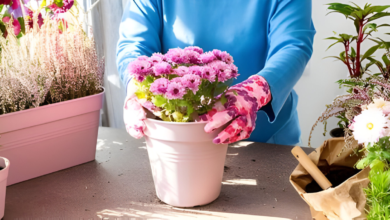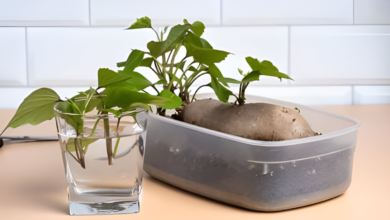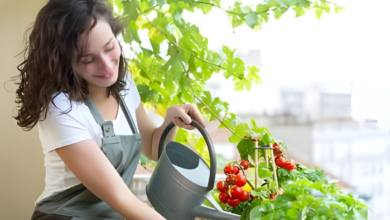Tips for Growing Roma Tomatoes in Pots

Table of Contents:
- Choosing the Right Container Size
- Selecting the Perfect Potting Mix
- Optimal Placement for Sunlight
- Proper Watering Techniques
- Fertilizing Your Roma Tomatoes
- Training and Supporting Your Tomato Plants
- Managing Pests and Diseases
- Pruning for Maximum Yield
- Harvesting and Storing Your Roma Tomatoes
- Troubleshooting Common Issues
Choosing the Right Container Size
When growing Roma tomatoes in pots, choosing the right container size is crucial for the success of your plants. Here are some tips on selecting the appropriate size for your Roma tomato plants:
- Consider the Size of the Plant: Roma tomatoes are determinate plants, meaning they grow to a certain size and stop. A 5-gallon container is suitable for one Roma tomato plant. If you plan on planting multiple tomatoes, increase the container size accordingly.
- Root Space: Tomatoes have extensive root systems. A deep container, at least 12-18 inches, provides ample room for the roots to grow and support the plant adequately.
- Drainage: Proper drainage is essential to prevent waterlogged soil, which can lead to root rot. Ensure the container has drainage holes at the bottom to allow excess water to escape.
- Room for Stability: Roma tomatoes can become top-heavy as they grow and develop fruits. Choose a sturdy container that provides stability and prevents the plant from tipping over.
- Consider Vertical Space: While the focus is often on the diameter of the container, don’t forget to consider the vertical space. Roma tomatoes can grow tall, so choose a container that allows for upward growth.
- Container Material: Select a durable container that can withstand the elements if placed outdoors. Materials like plastic, ceramic, or fabric pots are commonly used for growing tomatoes.
By taking these factors into account, you can ensure that your Roma tomatoes have adequate space to grow and thrive in a container environment.
Selecting the Perfect Potting Mix
When growing Roma tomatoes in pots, the potting mix you choose plays a crucial role in the success of your plants. Here are some tips on selecting the perfect potting mix for your Roma tomatoes:
- Rich in Nutrients: Look for a potting mix that is rich in nutrients like nitrogen, phosphorus, and potassium. These nutrients are essential for the growth and development of your Roma tomatoes.
- Good Drainage: It’s important to choose a potting mix that has good drainage. Roma tomatoes do not like soggy roots, so a well-draining mix will help prevent root rot and other moisture-related issues.
- Aeration: Opt for a potting mix that is light and airy to allow for proper aeration of the roots. This will help prevent compacted soil and promote healthy root growth.
- pH Level: Check the pH level of the potting mix to ensure it is suitable for tomatoes. Roma tomatoes prefer slightly acidic soil with a pH level around 6.0 to 6.8.
- Organic Matter: Consider a potting mix that contains organic matter like compost or aged manure. This will not only provide essential nutrients but also improve the overall soil structure.
- Pre-mixed vs. DIY: You can either purchase a pre-mixed potting mix specifically formulated for tomatoes or create your own mix. If you choose to make your own, ensure it has the right balance of components for optimal tomato growth.
Selecting the right potting mix is the first step towards growing healthy and abundant Roma tomatoes in containers. By paying attention to these factors, I can ensure my tomato plants have the best possible start for a successful growing season.
Optimal Placement for Sunlight
When growing Roma tomatoes in pots, it is crucial to place them in an area that receives an adequate amount of sunlight. Here are some tips for optimal sunlight placement:
- Choose a Sunny Spot: I recommend placing your Roma tomato pots in a location that receives at least 6-8 hours of direct sunlight per day. This will help the plants thrive and produce a bountiful harvest.
- Rotate the Pots: To ensure all parts of the plants receive sunlight evenly, consider rotating the pots every few days. This is particularly important if your plants are situated in an area where sunlight may be unevenly distributed.
- Avoid Shade: Keep your Roma tomato pots away from areas that are shaded for most of the day. Lack of sunlight can lead to slow growth and poor fruit development.
- Use Reflective Surfaces: If possible, place your pots near reflective surfaces such as light-colored walls or pavements. These surfaces can help bounce sunlight back onto the plants, maximizing their exposure to light.
Remember, sunlight is essential for the photosynthesis process, which is crucial for the growth and development of your Roma tomato plants. By following these tips, you can ensure your plants receive the optimal amount of sunlight needed for a successful harvest.
Proper Watering Techniques
I find that proper watering is crucial when growing Roma tomatoes in pots. Here are some techniques I follow to ensure that my plants receive the right amount of moisture:
- Consistent watering: I make sure to water my Roma tomatoes consistently to prevent them from drying out or becoming waterlogged. I typically water them every 2-3 days, depending on the weather and soil moisture levels.
- Deep watering: When I water my Roma tomatoes, I make sure to water deeply to encourage their roots to grow deeply into the soil. This helps the plants establish a strong root system that can better withstand fluctuations in moisture levels.
- Water at the base: I always water my Roma tomatoes at the base of the plants to avoid wetting the foliage. Wet foliage can lead to diseases such as blight, so I prefer to keep the leaves dry by focusing the water at the root zone.
- Use a watering can or drip irrigation: I find that using a watering can or drip irrigation system helps me control the amount of water my Roma tomatoes receive. This way, I can water the plants evenly without the risk of overwatering.
- Monitor soil moisture: I regularly check the moisture levels in the soil by inserting my finger into the pot. If the top inch of soil feels dry, I know it’s time to water. By monitoring the soil moisture, I can prevent both under and overwatering.
- Mulch: I like to mulch the surface of the soil around my Roma tomatoes to help retain moisture. Mulch also helps regulate soil temperature and suppresses weed growth, creating a healthier environment for my plants.
Proper watering is essential for the successful growth of Roma tomatoes in pots. By following these techniques, I can help ensure that my plants receive the right amount of moisture to thrive and produce a bountiful harvest.
Fertilizing Your Roma Tomatoes
I always make sure to fertilize my Roma tomatoes regularly to ensure they have the nutrients they need to thrive and produce an abundant yield. Here are some tips on fertilizing your Roma tomatoes effectively:
- Choose the Right Fertilizer: When it comes to fertilizing Roma tomatoes, using a balanced fertilizer with a ratio of 10-10-10 or 5-10-10 works well. This will provide the necessary nutrients without promoting excessive foliage growth over fruit production.
- Start Early: I typically begin fertilizing my Roma tomatoes once they have established a strong root system, usually around two weeks after transplanting them into containers.
- Fertilize Regularly: During the growing season, I fertilize my Roma tomatoes every two to three weeks. This consistent feeding schedule helps maintain strong, healthy plants that are more resistant to diseases and pests.
- Follow the Instructions: Always follow the manufacturer’s instructions when applying fertilizer. Over-fertilizing can lead to nutrient imbalances and damage the plants, so it’s essential to measure the amount accurately.
- Consider Organic Options: If you prefer organic gardening, there are several organic fertilizers available that are suitable for Roma tomatoes. Organic fertilizers can help improve soil health and promote beneficial microbial activity.
- Monitor Plant Health: Keep an eye on your Roma tomatoes to assess their nutrient needs. Yellowing leaves or slow growth could indicate a lack of nutrients, while excessive foliage growth with few fruits may signal too much nitrogen.
Remember, fertilizing is just one part of caring for your Roma tomatoes. Proper watering, adequate sunlight, and regular maintenance are also crucial for cultivating healthy and productive plants.
Training and Supporting Your Tomato Plants
I recommend providing adequate support for your Roma tomato plants to help them grow healthily and produce an abundant harvest. Here are some tips for training and supporting your tomato plants effectively:
- Use Tomato Cages or Stakes: Using tomato cages or stakes is essential to support the growth of your Roma tomatoes. Place the cage or stake in the pot at the time of planting to avoid damaging the plant’s roots later.
- Prune Regularly: Regular pruning helps your Roma tomato plants focus their energy on fruit production. Remove any suckers that grow in the crotch joint of two branches to encourage upward growth.
- Tie Up the Plants: As your Roma tomato plants grow, gently tie them to the cage or stake using soft plant ties. This will prevent the plants from bending or breaking under the weight of the fruit.
- Monitor Growth: Keep an eye on how your tomato plants are developing. Adjust the ties and supports as needed to accommodate their growth and ensure they are well-supported throughout the season.
- Remove Dead Leaves: Prune off any dead or yellowing leaves to promote air circulation and prevent diseases from affecting your plants. This also helps redirect the plant’s energy to fruit production.
Supporting your Roma tomato plants properly will not only result in a healthier plant but also a more bountiful harvest. By training and supporting your plants, you can enjoy delicious Roma tomatoes from your container garden.
Managing Pests and Diseases
I closely monitor my Roma tomato plants for any signs of pests or diseases to ensure they stay healthy and productive. Here are some tips for managing pests and diseases effectively:
- Inspect plants regularly: I make it a habit to inspect my Roma tomato plants regularly, looking for any signs of pests such as aphids, caterpillars, or whiteflies, as well as symptoms of diseases like blight or powdery mildew.
- Remove affected leaves: If I notice any leaves showing signs of disease, I promptly remove them to prevent the spread of the infection. I also remove any pests I see by hand or use a gentle spray of water to dislodge them.
- Use organic pesticides: When necessary, I opt for organic pesticides to control pest infestations. Neem oil or insecticidal soap are effective options that are gentle on the plants and the environment.
- Practice crop rotation: To prevent the buildup of diseases in the soil, I practice crop rotation, planting my Roma tomatoes in different locations each year.
- Mulch the soil: I mulch the soil around my Roma tomato plants to help retain moisture, suppress weeds, and prevent soil-borne diseases from splashing onto the leaves during watering.
- Provide proper air circulation: Adequate air circulation is crucial for preventing fungal diseases. I ensure that my plants have enough space between them and prune them regularly to promote good airflow.
By staying vigilant and taking proactive measures to manage pests and diseases, I can help my Roma tomato plants thrive and produce a bountiful harvest.
Pruning for Maximum Yield
When growing Roma tomatoes in pots, pruning is crucial to ensure maximum yield. Here are some tips on how to properly prune your Roma tomato plant:
- Remove Suckers: Suckers are the small shoots that grow between the main stem and branches. I recommend regularly removing these suckers to redirect energy to fruit production.
- Thin Out Leaves: Overly dense foliage can hinder air circulation and sunlight exposure, leading to disease and stunted growth. Prune excess leaves to promote better airflow and light penetration.
- Cut Diseased Branches: If you notice any diseased or damaged branches, promptly prune them to prevent the spread of illness to the rest of the plant.
- Focus Growth: By selectively pruning branches that are not producing fruit, I can redirect the plant’s energy to areas with more potential for fruit development.
- Maintain One Main Stem: To encourage vertical growth and support, I recommend keeping one main stem intact while pruning lateral branches that compete for resources.
- Regular Maintenance: Pruning is an ongoing process. I make it a habit to inspect my Roma tomato plant regularly and prune as needed throughout the growing season.
Remember, proper pruning techniques can help your Roma tomato plant thrive and produce abundant yields of delicious tomatoes.
Harvesting and Storing Your Roma Tomatoes
When it comes to harvesting Roma tomatoes, timing is crucial. I usually wait until the fruits are firm, fully colored, and have a slight give when gently squeezed. This indicates that they are ripe and ready to be picked. To harvest, I simply twist the tomato off the vine, being careful not to damage the plant.
To store Roma tomatoes, I prefer to keep them at room temperature if I plan to use them within a few days. However, if I have a large harvest and want them to last longer, I opt for refrigeration. Placing them in a breathable container such as a paper bag helps maintain their freshness and flavor.
If I want to store them for an extended period, I opt for freezing or canning. Freezing Roma tomatoes is straightforward – I wash and core them before freezing whole or chopped. For canning, I usually prefer to make sauces or salsa to preserve the tomatoes for future use. Following proper canning procedures ensures that the tomatoes remain safe to eat.
By harvesting at the right time and choosing the appropriate storage method, I can enjoy the delicious flavor of Roma tomatoes well beyond the growing season.
Troubleshooting Common Issues
I have encountered some common issues while growing Roma tomatoes in pots. Here are some troubleshooting tips to help you address these challenges:
- Yellowing leaves: If you notice your Roma tomato plant’s leaves turning yellow, it could be due to overwatering. Make sure the pot has proper drainage to prevent waterlogged soil. Adjust your watering schedule accordingly.
- Wilting plants: Wilting Roma tomato plants may be a sign of underwatering. Check the soil moisture regularly and ensure the plant receives adequate water. Wilting can also be caused by hot weather, so provide shade during peak hours.
- Pests: Keep an eye out for common pests such as aphids, whiteflies, and hornworms. You can handpick larger pests or use organic insecticidal soap to get rid of smaller ones.
- Diseases: Roma tomatoes are susceptible to diseases like blight and powdery mildew. To prevent these issues, avoid overhead watering, provide good air circulation, and remove any infected leaves promptly.
- Lack of fruit production: If your Roma tomato plant is not producing fruits, it may be due to inadequate pollination. Consider gently shaking the plant to help with pollination or introduce pollinator-friendly plants nearby.
- Leggy plants: Leggy plants with sparse foliage may need more sunlight. Ensure your Roma tomato plant receives at least 6-8 hours of sunlight daily to promote healthy growth.
Remember to monitor your Roma tomato plants regularly and address any issues promptly to ensure a successful harvest.




